SP5 Marcus P. Anderson, Army Combat Engineer, one of Cranford’s 86
By Don Sweeney, research by Stu Rosenthal and Bob Lopez
Military advice by Vic Bary, proofreading by Janet Ashnault
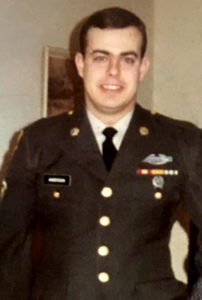
SP5 Marcus P. Anderson in his full dress uniform in 1968 before his second tour in Vietnam
As our team of researchers continues in our mission to introduce the brave men on our town’s memorial tablets, we were intrigued by the story of Marcus Anderson, an Army Combat Engineer. With Marcus’s home address of record just doors from Stu Rosenthal’s home, it sparked his curiosity and drove him to research the story behind a son of Cranford who grew up in the same environment as his three boys.
In January 1965, America, not yet officially committed to combat involvement, had only 23,000 advisors and observers in South Vietnam; 100 of who were Army Engineers. The fierce fighting nature and passionate determination of the Viet Cong became quickly evident. Their commando style of battle relied heavily on ambush tactics, land mines, and booby traps, hardly ever using conventional tools of war like tanks, armored motor vehicles or aircraft. After an attack on the Marine airbase at Pleiku on February 6, 1965 (see Joseph Minnock’s and Gilbert Secor’s stories), the US decided to begin sending large conventional ground troop units to South Vietnam. A ground war, it would seem, was inevitable. In a country with few roads, and the terrain being mostly swamps, rice paddies and thick jungle, helicopters were often the only means of moving ground troops from place to place. With the use of the new Air Mobility tactics for transportation of men and equipment, the need to construct airbases and landing zones was a priority early on. When the American architects of war decided that additional forces would be needed to support South Vietnam, they also determined that an expansion of infrastructure, i.e. roads, bridges, and highways was in order.
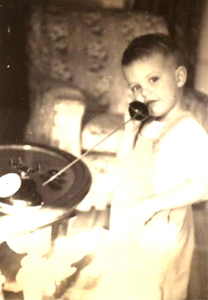
Marcus at home in the early years
Not only were Combat Engineers required to clear land for the needed new roads and bridges, but they would also need to clear the roadside vegetation 100 feet or more on each side of them to eliminate the ability of the guerilla soldiers to hide and strike passing convoys. To make their jobs even more treacherous, engineers would need to detect and neutralize thousands of artfully concealed land mines, placed to kill and maim soldiers, which had been present in South Vietnam for decades.
By 1967, Lyndon Johnson’s plans for escalation of forces to end the war quickly raised the number of American military personnel in South Vietnam to over 500,000, requiring even more combat and construction hardware. An escalation of road and bridge construction would have to match that growth. To meet that task, 40,000 combat engineers would be required. The job that lay ahead was said by some experts to be impossible. Large numbers of soldiers from non-engineer units were transferred, as well as new recruits to reach these levels. Our Cranford hometown hero Marcus Anderson’s enlistment on October 11, 1965 and initial tour of duty in Vietnam paralleled this period.
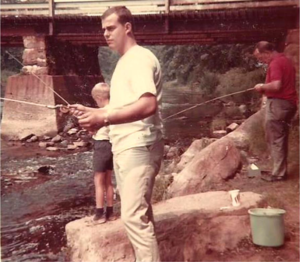
Marcus with his dad Clarence and his brother Bruce
Marc’s parents came to New Jersey in the 40’s; Grace from Brooklyn and Clarence from the Ozarks. They lived on a farm in Kenilworth and then in Caldwell with Clarence’s parents Joe and Beula.They subsequently lived in Elizabeth for a short time where Marc was born on January 2nd, 1947. The family then moved to Cranford, first to 5 Morningside Place and then settling into 37 Dartmouth Road. In 1968, just before Marc’s death, they moved to Odessa Florida, near Tampa.
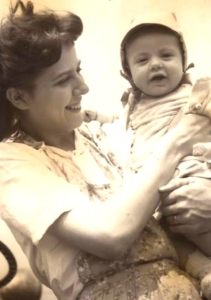
Marc with mom Grace before 1950
Our researchers found that Marcus was the oldest of four brothers. The remaining brothers had long ago moved out of town. We reached the youngest, Bruce, in Florida. He had little information for us as he was only eight when Marcus died, but did have some great photos to share with us. He was able to connect us with Craig, his older brother, who was thirteen in 1968. We reached him at his home in Austell, Georgia. He gave us a view into Marcus’s early life. He explained that his big brother Marc was very protective of his family. He felt that Marcus went into the Army to protect his younger brother Larry, who was 18 months younger than Marc. (Larry died in 2013.) Craig remembers the family communicating with Marc by recordings on a mini reel to reel tape player and receiving word back in the same fashion. Sorry to say he did not have or know the whereabouts of those tapes.
The Army would not allow two brothers from the same family to serve in the same combat zone at the same time. Even after serving one tour, Marcus’s protective nature made him sign up for another. We asked Craig if he knew of any close friends or relationships that we could possibly track down to tell us some stories that could help us to know Marcus a little better. He said the only girl that Marcus ever dated was a girl named “Evy” Lawler, but he didn’t know what became of her. We were not able to find any Evelyn Lawler on any of the search engines that we use, figuring she must have married, and not knowing her last name, we felt we had reached a dead end.
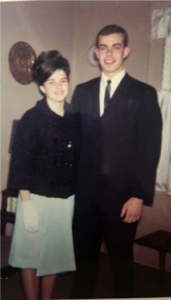
Evelyn Lawler and Marcus Anderson before the Holy Family “Formal Dance” in 1965. They dated for four years; the only girl Marc ever dated.
Combing through the 1965 Cranford yearbook, we found that Marc was a member of the varsity football team as well as involved in a few clubs. One was the Mask and Bauble theater club; it was nice to see a football player who had an interest in the arts. We thought it was a telling attribute of his character. He was also a sportswriter for the high school newspaper “Spotlight”. Continuing our quest to know Marcus we did online searches of the names under the football team’s group photo; many addresses were in Cranford. I went on a door knocking tour through town with hopes of finding a friend of our hero. Everyone I found told me how Marcus was a nice guy, but they were never very close to him. One of the stars of the 1965 football team was John Dreyer of Dreyer Farms on Springfield Avenue. He too said Marcus was a nice guy, but he didn’t have any further memories. What he did have was a connection that would open a door for us. A door that finally led us to someone who could acquaint us with the personal side of Marcus Anderson.
John’s wife, Martha, was close friends back in the sixties with Evelyn Lawler, now Evelyn Dougherty, and was still close with her. Evelyn was widowed several years ago and is living in Scotch Plains. He said he thought she’d speak with us but would ask her before giving us her contact information. He called me back in a few days with her number. We set up an interview for Saturday morning.
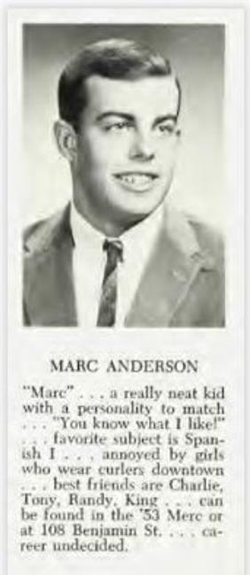
Cranford High School’s Yearbook, The Golden C.
Evy showed up at my home with a handful of amazing pictures from the sixties and some memories that she had been refreshing in her mind all week. My writing partner and researcher Stu Rosenthal arrived shortly after and we started to talk about her first boyfriend from 50 years ago – Marc Anderson. Evy told us about meeting Marc, as she called him, at the home of a friend, Paul Buonaguro. Soon they were playing mixed doubles at the clay courts on Springfield Avenue with her girlfriends Nancy Leonard and Martha Frank, now Martha Dreyer, and their friends. Marc had attended Brookside Place School, Orange Avenue Junior High School and then Cranford High School, and Evy attended Saint Michael’s Elementary school before attending Holy Family High School in Bayonne. Hence, they never crossed paths at school. In summer, the teens, in rentals from the Canoe Club, would beat the heat by purposely flipping their canoes. She explained that there were no public pools. They would double date at drive-in movies, play pitch and putt golf at Galloping Hill, take day trips to Olympic Park in Irvington for “Dime Day” or visit the Point Pleasant boardwalk. In colder months, watching movies at the Cranford Theater was their favorite pastime. Marc was always the driver in his tan ‘53 Mercury that he was well known for. I asked, “Always double dates?” She said “Yes, it was safe.” as she reflected upon the different era. Evy also remembers watching many a football game, bundled up against the chill, at Memorial Field. After graduating high school, she went to Union College, now UCC, with the plans of becoming a teacher. At this point Marc’s plans were not apparent, but it seemed that college was not for him. It took Evy by surprise when Marc announced that he had enlisted in the Army just 6 months after graduation and was shipping out to Fort Dix for basic training. She remembers joining his family to visit him there. Evy remained very close with the Anderson family throughout Marc’s enlistment, as they continued with their long-term relationship. Evy, an avid church goer, started attending mass daily when Marc went to Vietnam. She was relieved when he came home safe after his first tour, only to continue her daily anguish when Marc announced he had decided to return to Vietnam for a second tour. She remembered her first boyfriend not being himself upon his return; she told us he was very quiet and kept to himself. Not at all like the sometimes-goofy, lighthearted Marc who departed for service just two years earlier. It happened so fast; she did not even remember much before he was heading back to his unit in March of ’68 for another voluntary tour of duty.
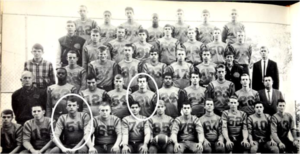
The 1965 CHS football team. Marcus and John Dreyer are highlighted.
In our interview with Craig he told us that his brother Marc’s service was first in a river patrol squadron. Most likely this was as part of the 630th Engineering Company, of which he was a member of for his entire tour of service. There was high demand for the skills of Army Engineers and upon their return to civilian life they were able to obtain well-paying jobs. It would seem Marc might have started a plan for a career after the Army. In a picture we received from brother Bruce; Marc is posing in front of a LARC-V (Light Amphibious Resupply Cargo Vehicle) holding his M-14 rifle. In a brief interview with a comrade from his company, we were told that a combat engineer in-country never let his weapon be out of reach. In the Army combat engineer documentary attached to the online story, it was stated “that they had the tool of their trade in one hand and a weapon of their occupation in the other”.
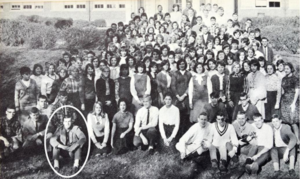
The mask and Bauble club, the Cranford High School theater club.
Marc’s military record lists many construction projects for which he and his unit were responsible. He was a part of creating several Special Forces camps and extensive work on and around Landing Zone Nancy, a complex helicopter base. His unit was also very active in the creation of Route 555, known to all as “The Street Without Joy”, a major thoroughfare the likes of which had never been seen in South Vietnam. On August 6, 1968, Marc was working on constructing a highway through a swampy area in Quang Ngai Province, South Vietnam. In the PBS documentary “Vietnam” Episode 8, it is mentioned that Quang Ngai was among the most notorious regions for land mines. “A soldier could be said to have courage for just taking a step in the fields of Quang Ngai.” While in the process of grading the highway, a passing vehicle struck a covered land mine. Tragically, the resulting explosion killed Marc instantly. He was just 21 years old and two months short of discharge. Stu Rosenthal uncovered an Army quarterly operational report dated October 31st, 1968 that was declassified in 1980. Statements in the 21 page “Operational Support, Lessons Learned” document tell of problems that were hindering the mine detection devices for this mission. Vic Bary, our military advisor, explained that the Army periodically required these types of reports. It seemed that the rainy season weather had rendered 15 of the 40 mine sweeping devices unusable. The lack of trained technicians and spare parts had left the unit short of the necessary tools to properly detect the hidden explosive devices. Our additional research also documented two other soldiers, one of them from Marc’s unit, who died in similar fashion, in a two-week period, in the same region. A simple off-handed recommendation to keep more spare parts was suggested for the future.
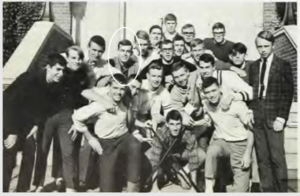
The writing staff from The Spotlight, CHS’s newspaper.
We asked Craig Anderson if he remembered the moment when he heard of his brother’s passing. He said “Of course, you never forget a moment like that.” On a day when their Florida home was filled with the entire family including grandparents, a pair of soldiers in full dress uniforms walked the long path from the street to their front door and everyone knew what it meant. Then he choked up and the phone went silent for a moment that seemed much longer. He continued to say it was the only time he saw his father cry; then another moment of silence. No more needed to be said. We changed the subject.
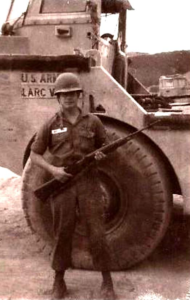
Marc and his M-14 rifle in front of a LARC-V. A
LARC vehicle is a hybrid boat and dump truck that is used in swamp construction.
We also asked Evy if she remembered that moment. She said “Of course, it was devastating. My mother came home from work early to break the news to me. I was in a state of disbelief.” We asked if they ever spoke of getting married after he returned. Her answer once again triggered those little hairs on my forearm to stand up like they have so many times during the interviews that I have conducted with family members of our heroes. She said after her dad died a letter to him from Marcus was found. In it, Marc stated that upon his return he would ask Evy to marry him. Like so many plans that our young Cranford 86 heroes had made, they never had the chance to see them through. For me it is the saddest thread that runs through each of the stories told so far.
Marc’s body was returned home where services were held at the First Presbyterian Church of Cranford, followed by a burial with full military honors at Graceland Cemetery in Kenilworth. Bruce Anderson has named his son in memory of his brother Marcus. The Anderson family is making plans to come to Cranford in 2020 to attend our Memorial Day service in which Marc’s Hometown Hero banner will be dedicated.
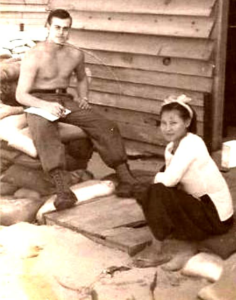
Outside his Hooch, Marc poses with an un-known woman. Local people were many times used to help with housekeeping and laundry.
SP5 Marcus Peter Anderson was an American patriot. He left his beloved town at the young age of 18 to answer his country’s call to service. It is our honor to profile the life of such a brave young man who represents the many Army Engineers who lost their lives working outside the spotlight, providing the structure necessary to allow our country to support and defend free countries worldwide. By war’s end 1,500 Army Combat Engineers had made the ultimate sacrifice in Vietnam.
Visit our website Cranford86.org for YouTube links and additional pictures. If you have information about any of our Cranford 86 heroes, please contact us at info@cranford86.org. The Cranford86 Memorial Day booklets featuring the stories of 21 of the Cranford 86 are still available.
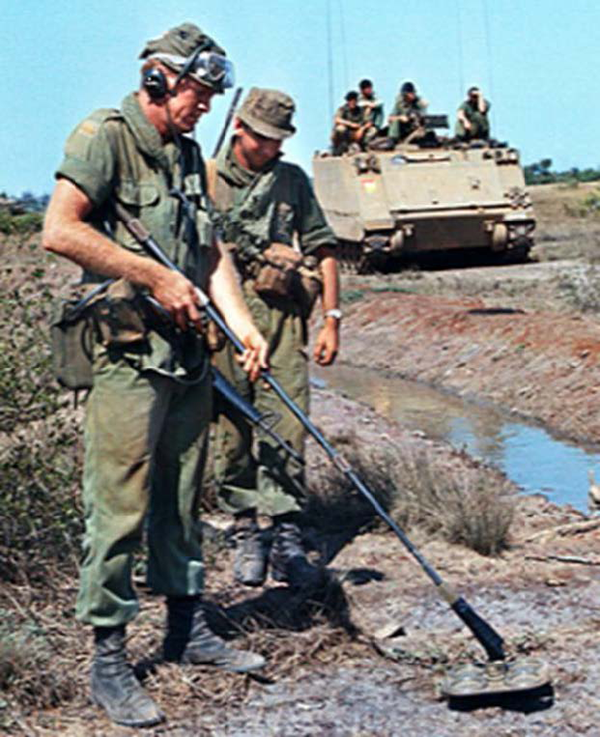
Electric minesweepers were used by
every engineering company. Because of the electronic nature of the device, it was adversely affected by moisture during the intense rainy seasons. A supply chain issue prevented the timely deliveries of parts to repair the damaged devices, most likely resulting in casualties that could have been prevented.
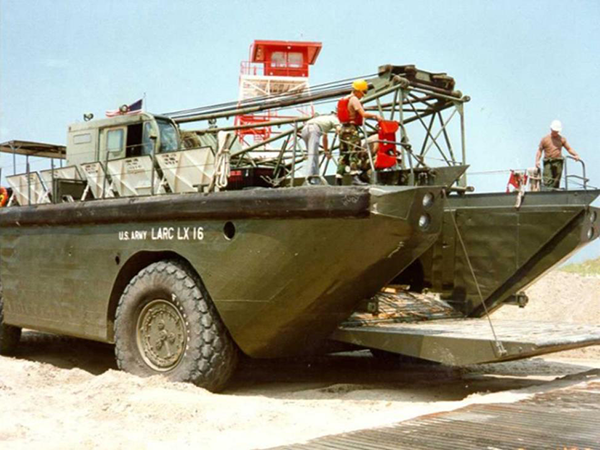
An army LARC with a crane onboard. Mars’s official Military Occupational Specialty (MOS) was as a shovel crane operator, but we could imagine that the LARC was used in their amphibious projects. Each wheel of the LARC had its own diesel engine.
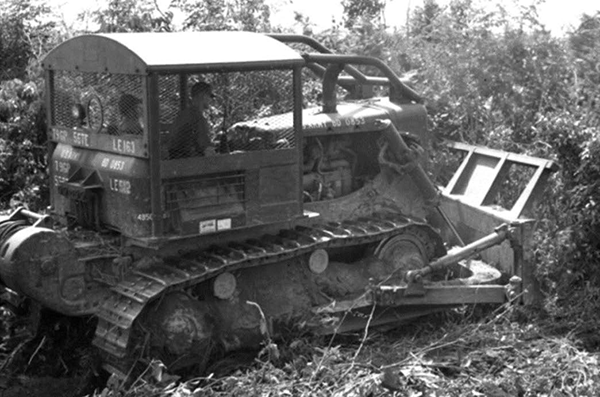
The Rome plow, the Army Engineers marvel, introduced in 1967. With its razor sharp blade, a team of 30 could clear 200 acres of dense jungle in a day. A landing zone or air strip could be created in days where before it would take weeks.
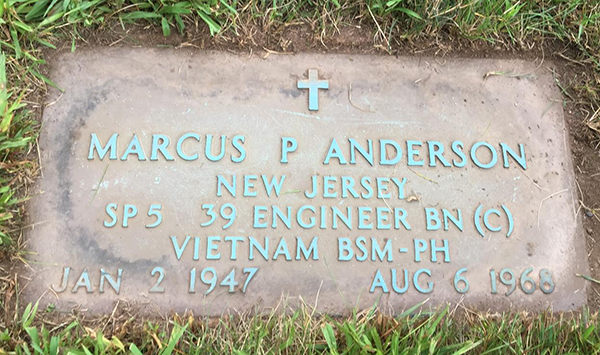
Stu and I visited Graceland Cemetery and found Marc’s
grave. Since his family moved out of New Jersey, we thought it may have been a while since anyone had. We cleared the grass from the government issued
bronze marker and vowed to return to maintain it in the future.
YouTube clips featuring The Combat Engineers in Vietnam. https://www.youtube.com/watch?v=nLX0x-r4FKo
